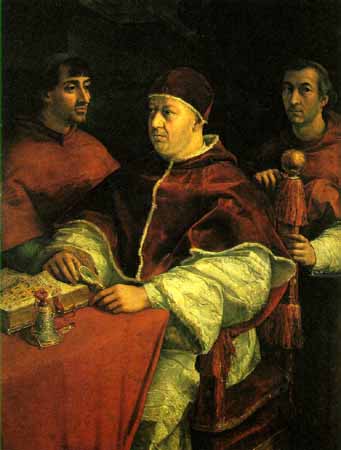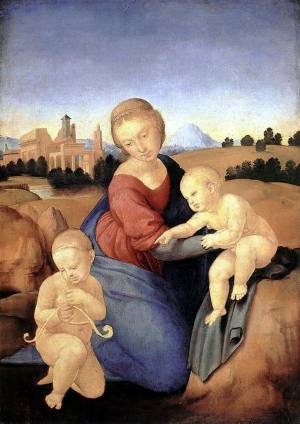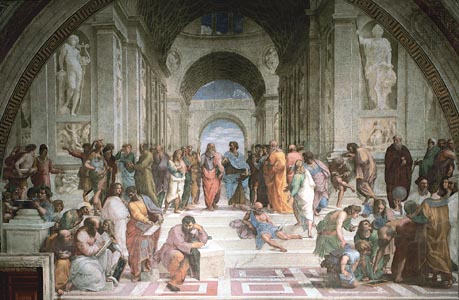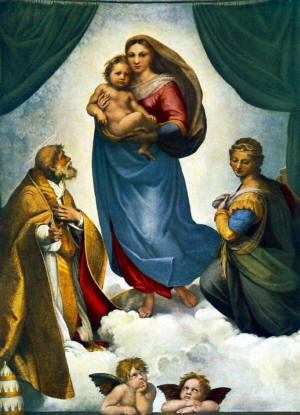Raphael
 Raphael Encyclopædia Britannica |
article page Raphael Encyclopædia Britannica |
article page
b. April 6, 1483, Urbino,
Duchy of Urbino [Italy]
d. April 6, 1520, Rome, Papal States [Italy]
Italian IN FULL RAFFAELLO SANZIO, master
painter and architect of the Italian High Renaissance. Raphael is best
known for his Madonnas and for his large figure
compositions in the Vatican in Rome. His work is
admired for its clarity of form and ease of
composition and for its visual achievement of the
Neoplatonic ideal of human grandeur.
http://www.britannica.com/bcom/eb/article/8/0,5716,64298+1,00.html
 Raphael (Vasari) Raphael (Vasari)
RAPHAEL OF URBINO,
Painter and Architect (5483-1520)
THE liberality with which Heaven now and again
unites in one person the inexhaustible riches of
its treasures and all those graces and rare gifts
which are usually shared among many over a long
period is seen in Raphael Sanzio of Urbino, who
was as excellent as gracious, and endowed with a
natural modesty and goodness sometimes seen in
those who possess to an unusual degree a humane
and gentle nature adorned with affability and
good-fellowship, and he always showed himself
sweet and pleasant with persons of every degree
and in all circumstances. Thus Nature created
Michelagnolo Buonarroti to excel and conquer in
art, but Raphael to excel in art and in manners
also.
http://rubens.anu.edu.au/imageserve/texts//vasari/vasari.raphael.html
Raphael
Italian Renaissance painter,
considered one of the greatest and most popular
artists of all time. Raphael was born Raffaello
Santi or Raffaello Sanzio in Urbino on April 6,
1483, and received his early training in art from
his father, the painter Giovanni Santi. In 1499
he went to Perugia, in Umbria, and became a
student and assistant of the painter Perugino.
 In 1504 Raphael moved to
Florence, where he studied the work of such
established painters of the time as Leonardo da
Vinci, Michelangelo, and Fra Bartolommeo,
learning their methods of representing the play
of light and shade, anatomy, and dramatic action. In 1504 Raphael moved to
Florence, where he studied the work of such
established painters of the time as Leonardo da
Vinci, Michelangelo, and Fra Bartolommeo,
learning their methods of representing the play
of light and shade, anatomy, and dramatic action.
In
1508 Raphael was called to Rome by Pope Julius II
and commissioned to execute frescoes in four
small stanze, or rooms, of the Vatican Palace.
The walls of the first room, the Stanza della
Segnatura, are decorated with scenes elaborating
ideas suggested by personifications of Theology,
Philosophy, Poetry, and Justice, which appear on
the ceiling. On the wall under Theology is the
Disputà, representing a group discussing the
mystery of the Trinity. The famous School of
Athens, on the wall beneath Philosophy, portrays
an open architectural space in which Plato,
Aristotle, and other ancient philosophers are
engaged in discourse.
After
the death of Pope Julius II in 1513, and the
accession of Leo X, Raphael's influence and
responsibilities increased. He was made chief
architect of Saint Peter's Basilica in 1514, and
a year later was appointed director of all the
excavations of antiquities in and near Rome.
Raphael died in Rome on his 37th birthday, April
6, 1520.
http://www.mcs.csuhayward.edu/~malek/Raphael.html
WebMuseum: Raphael
 "While
we may term other works paintings, those of
Raphael are living things; the flesh palpitates,
the breath comes and goes, every organ lives,
life pulsates everywhere." "While
we may term other works paintings, those of
Raphael are living things; the flesh palpitates,
the breath comes and goes, every organ lives,
life pulsates everywhere."
-- Vasari, Lives of the Artists
http://metalab.unc.edu/wm/paint/auth/raphael/
CGFA- Raphael
Carol
L. Gerten (Jackson)
 Raphael was
an Italian Renaissance painter who is considered
one of the greatest and most popular artists of
all time.He was born Raffaello Santi or Raffaello
Sanzio in Urbino on April 6, 1483, and received
his early training in art from his father, the
painter Giovanni Santi. Raphael was
an Italian Renaissance painter who is considered
one of the greatest and most popular artists of
all time.He was born Raffaello Santi or Raffaello
Sanzio in Urbino on April 6, 1483, and received
his early training in art from his father, the
painter Giovanni Santi.
In 1504 Raphael moved to Florence, where he
studied the work of such established painters of
the time as Leonardo da Vinci, Michelangelo, and
Fra Bartolommeo, learning their methods of
representing the play of light and shade,
anatomy, and dramatic action. His development
during his Florentine period can best be traced
in his numerous Madonnas.
In 1508 Raphael was called to Rome
by Pope Julius II and commissioned to execute
frescoes in four small stanze, or rooms, of the
Vatican Palace. After the death of Pope Julius II
in 1513, and the accession of Leo X, Raphael's
influence and responsibilities increased. He was
made chief architect of Saint Peter's Basilica in
1514, and a year later was appointed director of
all the excavations of antiquities in and near
Rome.
Raphael died in Rome on his 37th birthday, April
6, 1520.
http://sunsite.auc.dk/cgfa/raphael/
Art Gallery: Raphael
 Raphael
(Raffaello Santi) (1483, Urbino, 1520, Roma) Raphael
(Raffaello Santi) (1483, Urbino, 1520, Roma)
16 Madonnen-Bilder. Art Gallery is a
part of Christus Rex Project
http://www.christusrex.org/www2/art/Raphael.htm
Raphael: Works Viewable on the Internet
 Eine sehr umfangreiche
Linksammlung zu den Online-Werken von Raphael in
Museen, Gallerien, Bildarchiven und anderen
Websites. Eine sehr umfangreiche
Linksammlung zu den Online-Werken von Raphael in
Museen, Gallerien, Bildarchiven und anderen
Websites.
http://www.artcyclopedia.com/artists/raphael.html
Stanze e Loggia di Raffaello
 Pope Julius
II Della Rovere commissioned 25 year old Raphael
Sanzio in 1508 to paint the frescos in his four
room apartment on the top floor. Three of the
rooms were of modest dimensions, while the fourth
one was considerably larger; with the completion
of the work, the rooms became known as "The
Raphael Stanze" . Pope Julius
II Della Rovere commissioned 25 year old Raphael
Sanzio in 1508 to paint the frescos in his four
room apartment on the top floor. Three of the
rooms were of modest dimensions, while the fourth
one was considerably larger; with the completion
of the work, the rooms became known as "The
Raphael Stanze" .
They comprise the Stanza
della Segnatura, the Stanza of Heliodorus,
the Stanza of the Borgo Fire and the Sala of
Constantine.
The Raphael
Loggia consist of 13 arches
forming a gallery 65 meters long and 4 meters
wide. The construction was started by Bramante in
1512, under Pope Julius II and was completed by
Raphael Sanzio under the reign of Leo X. The
pictorial work was initiated in 1517.
The 52 scenes on the ceilings of the loggia are
still popularly referred as "The Raphael
Bible".
http://www.christusrex.org/www1/stanzas/0-Raphael.html
RAPHAEL'S ELIODORO CEILING
Kathryn V. Andrus-Walck
- kandrusw@mail.uccs.edu
The central audience chamber of the
residential rooms known as the Stanze in the
Vatican Palace is named after the subject of its
primary fresco decoration. the Expulsion of
Eliodorus from the Temple. Painted between 1512
and 1514 by Raphael Sanzio, an artist favored by
Pope Julius II and a rival of Michelangelo, the
Stanza d'Eliodoro has garnered relatively less
scholarly interest than the more well-known
Stanza della Segnatura. At one time, the Sienese
painter Baldassare Peruzzi was thought to have
painted the ceiling of the Stanza d'Eliodoro, but
most scholars now attribute to Raphael everything
but the decorative frames. Today, thousands of
visitors to the Vatican Museums pass through the
Stanza d'Eliodoro every day, many at breakneck
speed. Few have the chance to stop and to
understand how their own experience of moving
through the apartments of the Pope was
fundamentally altered by the decorations centered
there. Recreating the original experience of a
sixteenth-century visitor to these rooms--and
consequently rediscovering the meanings intended
by Raphael--is an occupation of art historians.
http://harpy.uccs.edu/eliodoro/elio.html
Leonardo, Raphael and Michelangelo:
Encyclopædia Britannica
The new style of painting that
Leonardo had invented in Milan was continued with
modifications by Bernardino Luini and others. It
had no immediate repercussions in his native
Florence, although the example of his unfinished
"Adoration" remained there. It is true
that Botticelli, Ghirlandajo, and Filippino Lippi
borrowed the broad outlines of the composition,
but they did not penetrate completely to the
innovational features inherent in it.
The
painter who benefited most from the example of
Leonardo was undoubtedly Raphael. The Stanza della Segnatura (the first
of a series of rooms in the Vatican constituting
Pope Julius II's apartments),
particularly the "School of
Athens," which Raphael painted
between 1508 and 1511, is one of the clearest and
finest examples of the High Renaissance style.

At
about the same time Raphael was working in the
papal apartments in the Vatican, Michelangelo had
undertaken the formidable task of decorating the
ceiling of the Sistine Chapel (1508-12),
also for Pope Julius II.
http://www.britannica.com/bcom/eb/article/4/0,5716,115374+9,00.html

|



